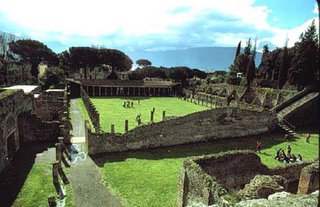The Roman Gladiator

Look at what my home boy, Smitty (From The Diesel Crew) sent me.
Very interesting....Read on my fellow Gladiators...
Gladiatorial Training & Combat
Gladiators were trained at special schools originally owned by private citizens, but later taken over by the imperial state to prevent the build up of a private army. Gladiators trained like true athletes, much like professional athletes do today. They received medical attention and three meals a day. Their training included learning how to use various weapons, including the war chain, net, trident, dagger, and lasso.
Each gladiator was allowed to fight in the armor and with the weapons that best suited him. They wore armor, though not Roman military armor as this would send the wrong political signal to the populous. Instead, gladiators wore the armor and used the weaponry of non-Roman people, playing the role of Rome's enemies.
For instance, a gladiator might dress as a Samnite in Samnite garb that included a large oblong shield ( scutum), a metal or boiled leather grieve (ocrea) on the left leg, a visored helmet (galea) with a large crest and plume, and a sword (gladius).
The gladiatorial garb for other rolls were:
A Thracian - wore ocrea on both legs, carried a small square shield, wore either a full visored helmet or an open faced helmet with a wide brim, and carried a curved Thracian sword with an angled bend in the blade;
A Secutor - took his name from the term for "pursuer" and fought virtually naked and bald, carrying a large oval or rectangular shield and a sword or dagger, wearing an ocrea on the left leg, leather bands at the elbow and wrists (manicae), and a round or high-visored helmet;
A Retiarius - symbolized the fisherman and wore only a loin cloth (subligaculum) and a metal shoulder-piece (galerus) on the left arm, and carried a net (iaculum), a dagger, and a trident or tunny-fish harpoon ( fascina). One variation on the Retiarius was the Laquearii who carried a lasso instead of a net.
Gladiators were paid each time they fought. If a gladiator survived three to five years of combat they were freed. Gladiators fought in arenas, the most famous of which was the Colosseum built by the Flavians. When one of the opponents in a contest was wounded, the crowd would typically shout " habet, hoc habet," he has had it. An opponent who felt he was defeated would raise his left hand with one finger extended as a request for mercy. It is not clear how the vote of life or death for the defeated opponent was decided though it may have involved the thumb.
If the decision was for death, the defeated opponent would ceremoniously grasps the thigh of his conqueror who would slay the loser by stabbing his sword into his neck. The dead body was removed by costumed attendants, one dressed as the ferry man Charon, and the other as Mercury. Charon struck the dead body with a hammer and Mercury poked the body with a hot iron disguised as his wand to assure the loser was dead. The winner would receive a symbol of their victory, such as a golden bowl, crown, or gold coin, along with a palm leaf symbolizing victory.
=================
It's very interesting how MMA and other combat athletes / sports have ressurected the days of Ancint Gladiators.
stay strong, stay tough,
--Zach--
p.s. - To start training like a Gladiator, go here Now!

